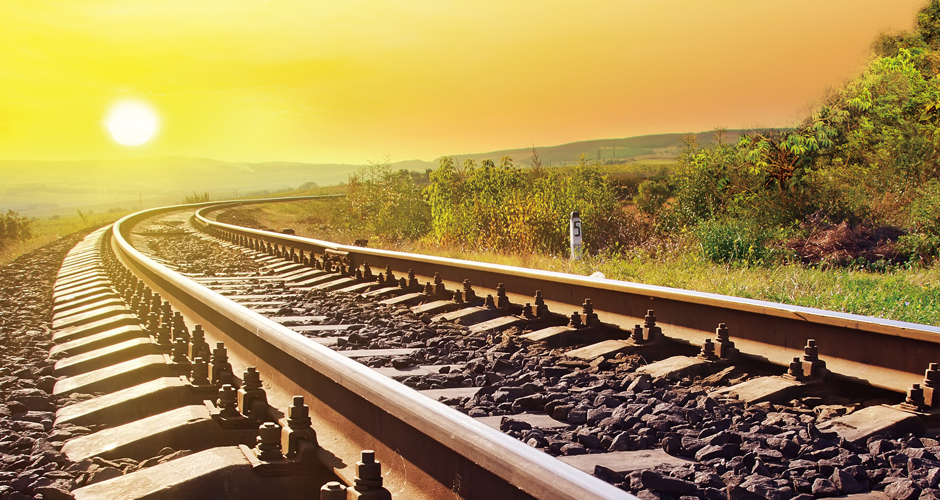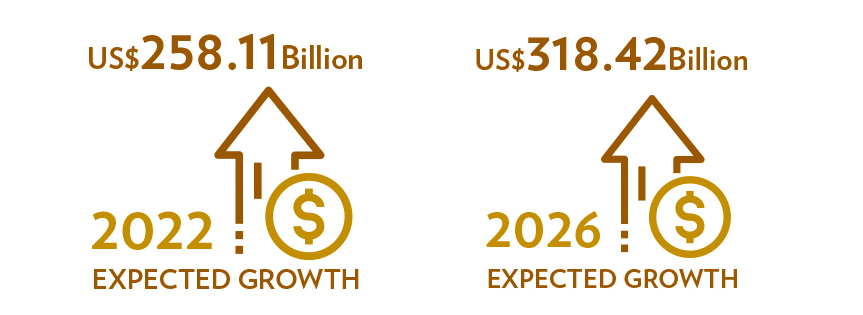 22nd December 2022
22nd December 2022
Rail freight has not always had the profile of other major modes of transport such as ocean transportation and air cargo.
During the recent disruption to the global supply chain, rail has been providing a consistently reliable mode of transport for both transcontinental routes in Asia, North America, and Europe as well as inland markets.
The global rail freight market is expected to grow to US$258.11 billion in 2022 from US$242.53 billion, a compound annual growth rate (CAGR) of 6.4 percent according to Reportlinker.com. By 2026 the global rail freight market will increase to US318.42 billion at a CAGR of 5.4 percent, according to the report.

In a separate report by Research and Markets the US rail freight market is estimated at US$58 billion in 2022, while China is forecast to reach US$35.4 billion by 2026. Other big investors in railways like Japan and Canada, are forecast to grow by 2.8 percent and 4.1 percent respectively in 2022.
North America is the largest continental global rail freight transport market owing to its extensive network of railways spanning over 200,000 miles.
It is the Asia-Pacific market that is driving forward most aggressively with new rail freight transport infrastructure projects providing vital transport links to land locked countries across the region and importantly incorporating smart systems and technology across the network.
Emerging economies in Asia-Pacific are also upgrading rail freight transport notably, like Cambodia, Thailand and Laos all with new rail connections to China either under construction or completed in recent years. This development has helped boost trade and alleviate congestion at many of the ports and on the roads.
The latest cross border connection between China and Laos opened in December 2021 and has recorded more than one million tons of cargo moving between the two countries, according to the Laos-China Railway Co., Ltd. (LCRC).
Goods carried on the China-Laos Railway, have shown a rising trend, including commodities, fertilizers, electronics, photovoltaics, textiles and vegetables shipped from China to Laos, while iron and zinc ore, cassava flour, barley rice, charcoal, rubber, potash and fruits were transported from Laos and neighbouring countries to China.
Out of the 1,076,500 tons total of cross-border goods, 263,400 tons originated from China and shipped to Laos, while 813,100 tons transported from Laos to China, with an average monthly growth rate of 16.95 percent.
Among them, the China-Laos Railway has been in operation for 9 months, and the total value of international freight has exceeded 10 billion yuan, becoming the “golden line” linking China and ASEAN countries. (Source: Ta Kung Pao)
Plans are already underway to launch the Lancang-Mekong Express, an international freight train connecting China and Laos, according to the LCRC.
Rail has become a critical mode in strategic plans to develop a more effective multimodal transport network in Europe.
The European Commission’s new and extensive investments aim to make the European multimodal network more efficient. The aim of the plan is to create an affordable, reliable, and effective rail network, improved inland waterways navigation and infrastructure in maritime ports and a balanced interconnection between different modes of transport.
The rail related investments will provide the backbone for infrastructure developments within the TEN-T* network and will primarily target railways, rail-road terminals, multimodal logistics hubs, inland waterways, and the maritime and inland ports.
The ultimate objective of TEN-T is to close gaps, remove bottlenecks and technical barriers, as well as to strengthen social, economic and territorial cohesion in the EU, according to the European Commission website.
Tracking and tracing systems of rail freight using GPS and GSM helps the transportation organisations to overcome the rail freight transportation drawbacks such as loss and theft. It provides full-fledged security and monetisation of freights, and more effective and efficient freight transportation over short distances for smaller loads.
*The Trans-European Transport Network (TEN-T) policy addresses the implementation and development of a Europe-wide network of railway lines, roads, inland waterways, maritime shipping routes, ports, airports and railroad terminals.
This year Hutchison Ports has multiple new rail freight service extensions in China, Asia and Europe.
In Shenzhen, South China, Hutchison Ports YANTIAN established new inland port connections in Longchuan County and Jiangmen in Guangdong Province, Yueyang in Hunan Province and Nanchang in Jiangxi Province.
At Hutchison Ports Pakistan, rail operations commenced in December 2021. Since then, over 79 trains have been successfully operated from the terminal for base station in Lahore transporting approximately 5,976 TEU. It also offers to exclusively make customised arrangements with several carriers for the movement of their containers via train to provide Port-to-Door and Door-to-Port freight train service to its customers.
Hutchison Ports Felixstowe in the UK introduced its 38th daily rail service which now connects the port with Birch Coppice in the British Midlands.
While Synergy, the logistics operator of Hutchison Ports BEST, continues to provide a variety of cross-border railway network infrastructure services between the Port of Barcelona and France, offering ‘all-in-one’ port-to-door solutions in logistics, terminals and customer service.
Shifting freight from trucks to rail reduces highway wear and tear and alleviates the cost of building new roads and highways.
A study by the American Association of Railways claims that rail is three to four times more fuel efficient than trucks, also using rail reduces greenhouse gas emissions by up to 75 percent, on average. A single freight train can also replace several hundred trucks, freeing up space on the highway for other motorists and reduce traffic congestions.
Freight railroads account for just 0.5 percent of total US greenhouse gas emissions and 1.9 percent of transportation-related greenhouse gas emissions according to the US Government Environmental Protection Agency.
The environmental advances in railway freight technology across the country’s operations have reduced the impact on the environment. In 2021 alone, the US freight railroads consumed 790 million fewer gallons of fuel and emitted nine million fewer tons of carbon dioxide than they would have if their fuel efficiency had remained constant since 2000.
In North America, Canadian Pacific Railway expanded its hydrogen locomotive programme to include the conversion of three line-haul locomotives and the installation of two hydrogen production and fuelling facilities. Both hydrogen production and fuelling facilities will deploy electrolyser plants to produce hydrogen fuel from water. One of the hydrogen production plants will operate on renewable solar power to produce a zero GHG emissions hydrogen fuel to power hydrogen locomotives. It will be the first line-haul using hydrogen-powered locomotive combining hydrogen fuel cells and battery technology to power the locomotive’s electric traction motors.
Rail’s limiting factor when compared to ocean transport is of course its capacity, restricted to a few hundred containers per block train when compared to the 24,000 TEUs carried on the largest box ships.
For large continents like North America, Europe, Australia and countries such as India and China, rail comes into its own as the most cost-effective way of transporting commodities, general freight and consumer goods over long distances. The cost per ton kilometre also moves in favour of rail between distances of 500 and 700 miles when compared to trucking.
Of course, there are many variables to consider such as how close a shipper or consignee to the rail head and the last mile transport by road, as an additional cost.
In many port areas around the world, rail connection means that freight can keep moving irrespective of local road congestion. Rail also provides direct access to inland areas, which benefits the development of the economy in the hinterland and provides opportunities for manufacturers, distribution warehouses and logistics companies close to the railway and intermodal hubs.
The future of traditional rail freight seems to have few challengers, but the ‘sky train’ built in Xingguo County, Jiangxi Province in China, may hold a glimpse of the future.
The experimental train rides along a track suspended 10 metres in the air by a steel structure and while it uses Maglev technology, the train travels underneath the structure, leading some to dub it a “sky train.” The train without a power supply can reach at a speed of 80km/h, the maximum speed for local domestic underground, and its top operational speed is approximately 120km/h.
Also looking to the future nascent Hyperloop technology is being developed in Dubai which promises freight travelling at the speed of flight and closer to the cost of trucking. The technology developed by Virgin Hyperloop uses a ‘near vacuum’ environment within a tube, which enables high speeds, low power consumption, and almost completely removes aerodynamic drag. Inside the tube, battery-powered pods glide at speeds of up to 670mph (1,078Km/h).
The 200th anniversary of the inauguration of the first commercial railway approaching in 2030, rail has come a long way from the days when Stephenson’s Rocket steam train first made its way along the Liverpool to Manchester railway. Rail continues to be the ‘backbone’ of transportation in many countries and looks like it will stand the test of time.